
When it comes to your skincare routine, it seems like there is never a shortage of steps needed to treat your skincare concerns. If you are looking for quick and noticeable results, adding an acid to your skincare routine is often worth the added step.
In the past few years, multiple forms of acids have become readily available as stand-alone products and as skincare treatments combined with other actives. They treat conditions such as texture, hyperpigmentation, dryness, fine lines, wrinkles, dullness, and even acne.
But what acid should you add to your skincare routine? Should you use one or more? These are just a few of the questions that can have you deciding to skip acids all together.
While there are many acids products out there for your skin, you’ll see that by basing your choice on your skincare concerns and skin type, you’ll be able to narrow down your options pretty quickly.
But why should you even try an acid at all? Here is a guide to using acids in skincare:
This post contains affiliate links, and any purchases made through these links will result in a commission for me at no extra cost to you. Please read my Disclosure for additional information.
The Benefits of using Acids in your Skincare Routine
Before wading into all the various acids, let’s discuss why you might want to give acids a try. The most well-known exfoliating acids, water-soluble alpha-hydroxy acids, reduce the pH level of the skin and in the process, dissolve dead skin cells and exfoliate the skin.
In essence, acids break apart the glue that holds skin cells together.
After this layer of dead skin cells is removed, it is not surprising to see skin that is brighter, smoother and more youthful. Exfoliation can also help improve skin texture and reduce breakouts.
I prefer to use products that contain exfoliating acids instead of products that offer a physical exfoliation. Physical exfoliation does not have a chemical aspect to its exfoliation but rather a physical grain or abrasive exfoliates skin cells. This can be damaging to the skin, so for regular exfoliation, chemical exfoliants are my go-to.
Skincare Acids
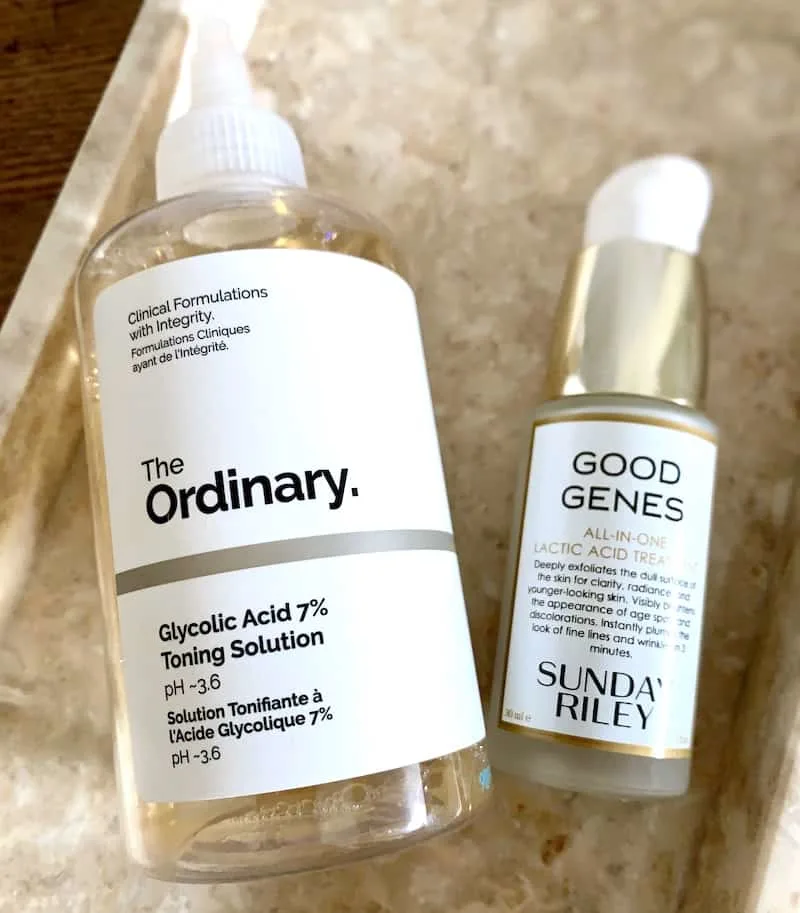
Glycolic Acid
Derived from sugarcane, glycolic acid is a small molecule that can penetrate into the layers of the skin and dissolve dead skin cells. Glycolic acid also supports the production of collagen and elastin. It may even reduce acne by unblocking pores and reducing excess oil.
As we age skin turnover decreases, so acids are a great addition to any anti-aging skincare routine. Once the skin is exfoliated, it will look more luminous and radiant. It also helps your skincare products perform and absorb better while creating a smooth base for makeup.
Percentages and product types containing glycolic acid are wide-ranging.
From cleansers and moisturizers to peels and masks, how you use glycolic acid and other acid products depends on your skin type and how it tolerates the acid.
I like The Ordinary Glycolic 7% Toning Solution after cleansing, as it exfoliates skin with a pH of 3.6. If you are just starting out and concerned about irritation, take it slow by using it once or twice a week and see how your skin responds.
Related Post: AHA vs BHA Skincare Exfoliants: What is the Difference?
Lactic Acid
Derived from milk or fruit sugars, the lactic acid molecule size is larger than glycolic acid, so while it doesn’t penetrate the skin as deeply, it is gentler on the skin and typically causes less irritation than glycolic acid. Lactic acid is also less likely to compromise your skin’s barrier than stronger acids.
My favorite lactic acid treatment of all time, Sunday Riley Good Genes All-in-One Lactic Acid Treatment, is formulated with purified lactic acid, licorice and lemongrass for additional brightening and prickly pear extract to soothe redness.
Lactic acid happens to be my favorite exfoliating acid for my sensitive skin. A few times a week works like a charm for me and I always wake in the morning with brighter, smoother, clearer skin after using lactic acid treatments, and especially after using Good Genes.
Related: Sunday Riley Good Genes Drugstore Alternatives from The Ordinary and The Inkey List
Malic Acid
Derived from apples, malic acid is an alpha-hydroxy acid that is even gentler on the skin than glycolic and lactic acids. Its molecule size is larger, resulting in exfoliation that is closer to the skin’s surface. While this is good news for sensitive skin, it tends to be less effective than other acids with smaller molecules.
Like other alpha-hydroxy acids, malic acid acts as a humectant attracting and retaining moisture in the skin. Malic acid will often be combined with other AHAs and BHAs in skincare formulas to enhance the effectiveness of other acids.
Malic acid is one of five AHAs and BHAs in Dr. Dennis Gross Alpha Beta Universal Daily Peel. The other acids are glycolic, lactic, mandelic, and salicylic. It is also formulated with resveratrol, vitamin C, and a retinoid.
Talk about anti-aging ingredients! This is one of my favorite at-home peels. It’s not too strong and conveniently packaged in single-use packets. It’s perfect for travel as well.
Salicylic Acid
Derived from willow bark, salicylic acid is a beta-hydroxy acid (BHA). Like AHAs, salicylic acid exfoliates the skin but unlike AHAs, it is oil-soluble, allowing it to penetrate the pores and dissolve sebum. Salicylic acid can penetrate the skin deeper and unclog blocked pores.
Unfortunately, I have never been able to use salicylic acid, as it has always strongly irritated my skin. Not surprisingly, products containing willow bark also irritate my skin.
I wish I could use it because it truly is an acne buster, all while acting as an anti-inflammatory helping blemishes heal quicker.
Many rave about Farmacy Honeymoon Glow AHA Resurfacing Night Serum with Hydrating Honey + Gentle Flower Acids. It contains a 14% blend of acids including glycolic acid, lactic acid, willow bark extract, hydrating hyaluronic acid, and soothing honey.
Mandelic Acid
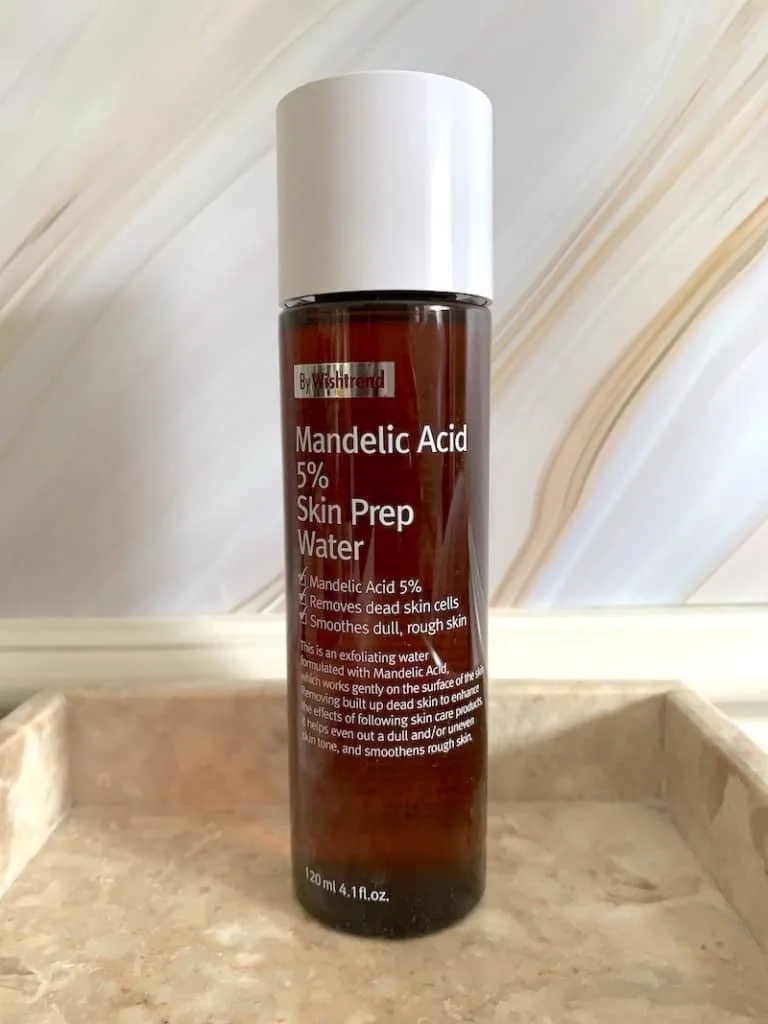
Derived from bitter almonds, mandelic acid is an oil-soluble alpha hydroxy acid that not only exfoliates but also treats hyperpigmentation, dark spots, and uneven skin tone, and regulates sebum production.
I’ve been testing By Wishtrend Mandelic Acid 5% Skin Prep Water as it is geared toward skin that is more sensitive. It also contains Centella asiatica to calm inflammation, Vitamin B5 functions to moisturize, hyaluronic acid for hydration, and beta-glucan to reduce redness.
I use it on evenings that I don’t use any other acids or retinoids (or vitamin C). After cleansing, I apply it with a cotton pad as my toner.
It makes my skin tingle slightly and like other acids, brightens and makes my skin appear more radiant after using it. It’s designed for all skin types and even though it contains an exfoliating acid, this is one product that can be built up to daily use.
If you are looking for a stronger mandelic acid formulation, The Ordinary Mandelic Acid 10% + HA contains 10% mandelic acid plus a new-generation hyaluronic acid that penetrates deeper into the skin resulting in better moisture retention that lasts longer.
Tartaric & Citric Acids
Lesser-known AHAs include tartaric and citric acids. Tartaric acid is derived from fermented grapes and is often used to regulate the pH of glycolic or lactic acid formulas and to strengthen their exfoliating abilities.
Like tartaric acid, citric acid regulates pH, acts as a preservative and removes impurities from skincare formulations.
Polyhydroxy Acids
Polyhydroxy acids (PHAs) have larger a molecule size than AHAs and BHAs thereby providing a gentler chemical exfoliation.
PHAs are filled with antioxidants, strengthen elasticity and support collagen growth. And since they don’t penetrate deeply into the surface of the skin, they cause less photosensitivity. Sensitive skin that cannot tolerate AHAs and BHAs may benefit from PHAs.
Phytic Acid
Phytic acid is not an AHA nor a BHA but rather an antioxidant and protects the skin from damage from free radicals. It also works to minimize pores and prevent the formation of blackheads.
Peter Thomas Roth PRO Strength Exfoliating Super Peel contains 35% Phytic Acid Extreme plus glycolic and salicylic acid for a rinse-off chemical exfoliation to improve the appearance of texture.
Azelaic Acid
Found in some grains and yeast that naturally occur on the skin, azelaic acid is not an AHA or BHA, but rather a dicarboxylic acid.
This is a multi-tasking acid. It acts as an antioxidant and targets skin issues such as inflammation hyperpigmentation, texture, and even rosacea. Plus it reduces the production of keratin, which can block pores and cause acne.
Ascorbic Acid
Ascorbic acid is a water-soluble form of vitamin C that can benefit your skin in so many different ways! A powerful antioxidant, ascorbic acid (vitamin C) neutralizes free radicals that cause oxidation in the skin and the formation of the signs of aging, i.e. lines and wrinkles.
It also brightens your complexion while helping to reduce hyperpigmentation and inflammation. Plus it supports collagen production, for a more plumper and more youthful appearance to your skin.
Ascorbic acid is notoriously difficult to stabilize, so make sure your ascorbic acid product is packaged in an airtight container. There are so many great affordable vitamin C products on the market.
A favorite drugstore vitamin C over the years has been Timeless 20% Vitamin C + E Ferulic Acid Serum. I always apply ascorbic acid products during the day to get an extra boost against free radicals and save other anti-aging heavy hitters like retinoids for the evening.
Related Post: A Guide to The Ordinary Vitamin C Skincare Products
Ferulic Acid
Ferulic acid is an antioxidant that is often combined with other antioxidants to boost their effectiveness. You’ll often see it included with vitamin C and E products, like in the Timeless serum mentioned above, to stabilize and enhance the formulas to provide more complete antioxidant protection.
Like ascorbic acid, ferulic acid protects skin against free radical damage and reduces the appearance of fine lines and wrinkles.
Hyaluronic Acid
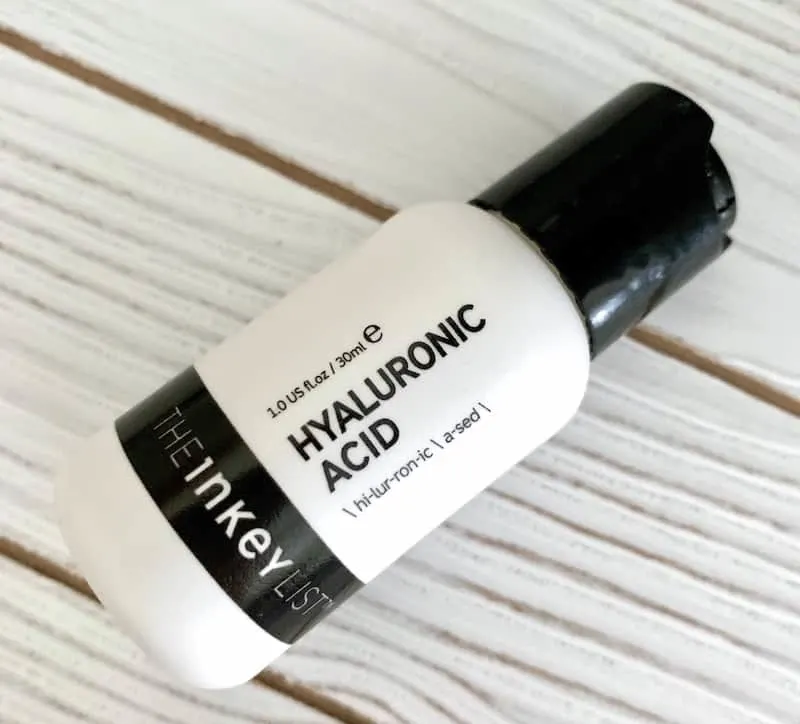
Hyaluronic Acid has become a popular skincare ingredient in the past few years as skincare lovers have caught on to its wonderful hydrating effects. It’s a superstar hydrator since it can retain up to 1,000 times its weight in water.
This humectant also prevents trans-epidermal water loss. It plumps the skin, and as a result, the appearance of fine lines and wrinkles will be reduced.
The Inkey List Hyaluronic Acid Serum contains 2% hyaluronic acid plus Matrixyl 3000, a peptide that supports natural collagen production, improving skin elasticity and firmness.
I can’t say enough about this product. It sinks into your skin quickly and is not sticky like other hyaluronic acid products that I’ve tried.
Related Post: The Inkey List vs The Ordinary: Anti-Aging Skincare on a Budget
Omega Fatty Acids
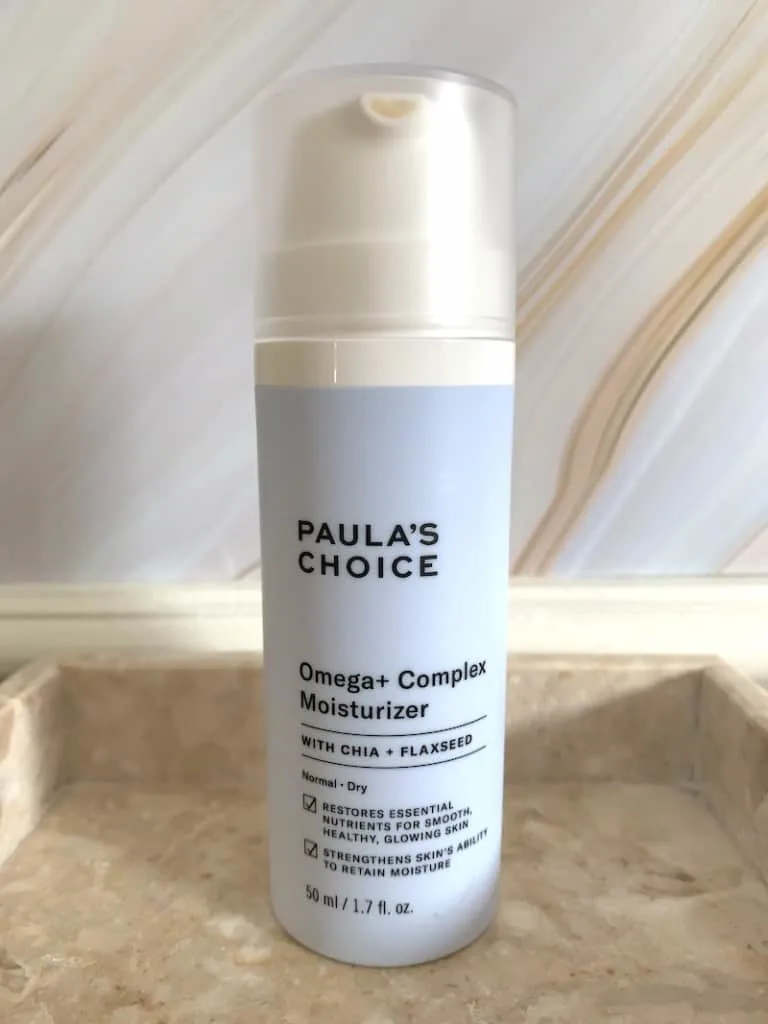
Although these acids don’t exfoliate like many of the acids already discussed, omega fatty acids are very beneficial to the skin.
Omega fatty acids are essential fatty acids that our body can’t make on its own. Some of the most popular fatty acids include alpha-linoleic acid (omega-3), linoleic acid (omega-6) and (non-essential fatty acid) oleic acid (omega-9).
They support the outermost layers of your skin, repairing the skin barrier. They help improve elasticity, prevent trans-epidermal water loss, and reduce photo and environmental damage for a more youthful-looking appearance.
Paula’s Choice Omega+ Complex Moisturizer is a recent favorite that has a long list of active ingredients, including omega fatty acids. This moisturizer contains chia seed oil that is rich in alpha-linolenic acid to fight inflammation.
It also contains linoleic acid, oleic acid, a host of ceramides, squalane, hyaluronic acid, and passion fruit & guava extracts in a luxuriously light whipped texture. It is super moisturizing and ideal for dry parched skin.
How to Add Acids into Your Skincare Routine

How to Use Exfoliating Skincare Acids
You’ll find exfoliating acids in many different forms, mostly in serums or liquid. I like to use liquid acid exfoliants after cleansing and toning and pat it into my skin with my fingers or apply it with a cotton pad.
Acid exfoliants are also commonly found in serum treatments that should be applied as the treatment step of your skincare routine after cleansing and toning but prior to applying a moisturizer.
I tend to use exfoliating acids at night only a few times a week, but there is no rule that they must be used in the PM.
Just make sure that you are using a sunscreen with a high SPF since exfoliating acids can make your skin more sensitive to ultraviolet rays.
How to Use Non-Exfoliating Skincare Acids
You can be a little more liberal with hydrating and plumping acids. Sometimes I use hyaluronic acid twice a day in the cold winter months. Omega fatty acids in Paula’s Choice Omega + Moisturizer are also another go-to, sometimes twice a day when my skin is extra dry.
Please note that there is such a thing as overdoing it. Certain omega fatty acids like oleic acid can aggravate acne. So remember, all in moderation.
Exfoliating Skincare Acids For Beginners
If you are just starting out, you’ll need to see how your skin responds to exfoliating acids. Gentler acids like mandelic or malic may be a good place to start.
Be sure to check the product’s percentage of acid in each formulation, because you will find quite a difference between concentrations of 5% and 10% or more in exfoliating acid formulations.
Regardless of which acid you are using, be sure to never use exfoliating acids around your eyes where your skin is thinner and more sensitive.
PLEASE NOTE: If you have a darker skin tone, you may be at risk for developing hyperpigmentation if the acid you use is too strong and irritating to your skin, so be sure to research and test before applying strong exfoliating acids.
Exfoliating Acids for Sensitive Skin
If you have sensitive skin, you may want to start with gentler exfoliating acids. Mandelic, malic and azelaic acids are gentler than lactic and glycolic acids and can be found in lower concentrations.
Similar to retinoids, you may want to start out only once or twice a week and see how your skin responds. You can then build up slowly to more regular use.
Final Thoughts on Using Acids in Your Skincare Routine
Adding an acid to your skincare routine is a fantastic way to brighten and smooth your skin quickly without waiting weeks for results.
Keep in mind that the results won’t be drastic. While exfoliation will occur on the surface layers of your skin only, you may be surprised to see more radiant and luminous skin after using exfoliating acid treatments.
Have you tried acids in your skincare routine? I’d love to know what worked (and what didn’t work) for you! Let me know in the comments!
Thanks for reading, and until next time…
Like This Post? Pin It!
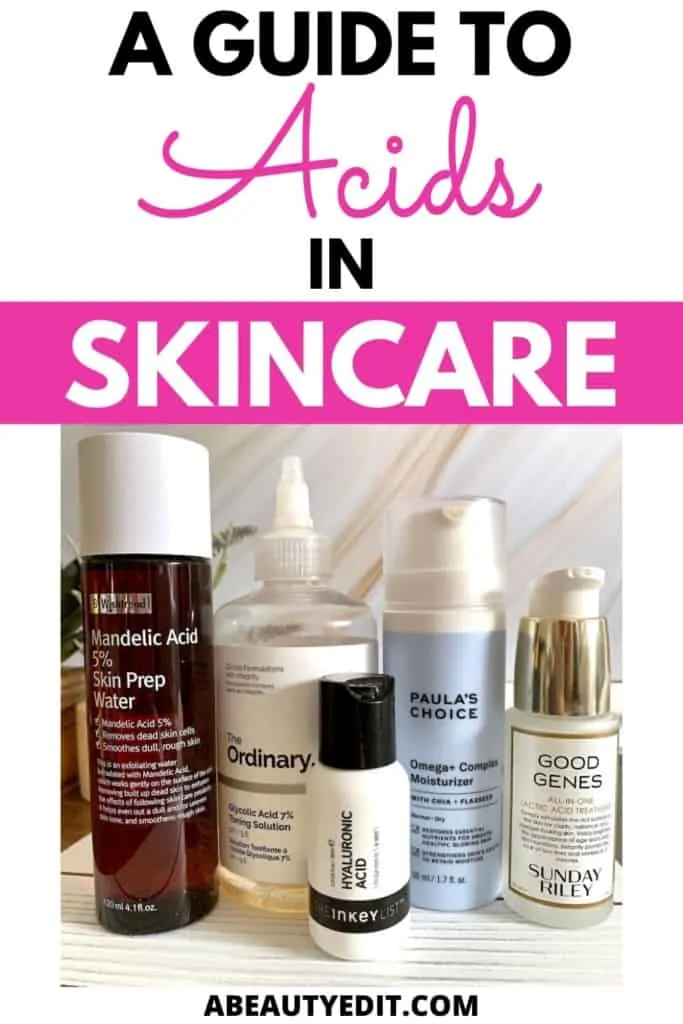


Line Helene
Sunday 19th of July 2020
Hi, I can't decide of trying the: PAULA'S CHOICE RESIST WEEKLY RESURFACING TREATMENT WITH 10% AHA
Or: Wishtrend MANDELIC ACID 5% SKIN PREP WATER
Do you thing one is better than the other?
Sarah
Sunday 19th of July 2020
Hello! I think you should choose based on your skin type and skin concerns. While both contain acids, Paula's Choice RESIST Advanced Smoothing Treatment 10% AHA appears to be a stronger treatment with 10% AHAs in the form of glycolic, lactic, malic, and tartaric acids, plus a beta-hydroxy acid in the form of salicylic acid. By Wishtrend Mandelic Acid 5% Skin Prep Water contains 5% mandelic acid. Mandelic acid tends to be gentler and less irritating than other acids such as glycolic acid. So it really depends on how sensitive your skin is and if you are looker for a milder exfoliation (By Wishtrend) or a stronger exfoliation (Paula's Choice). Thanks for reaching out!